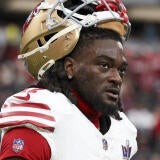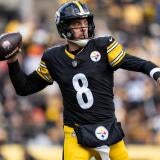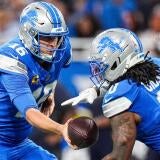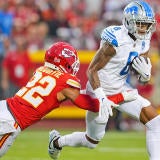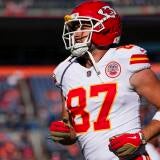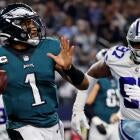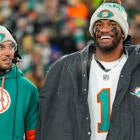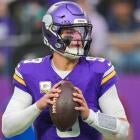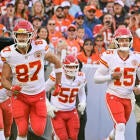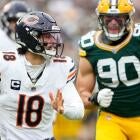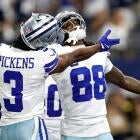Shedeur Sanders is exactly who the Browns thought he was ... and that's not a bad thing
The tape is the tape -- and that's why Sanders is currently QB4
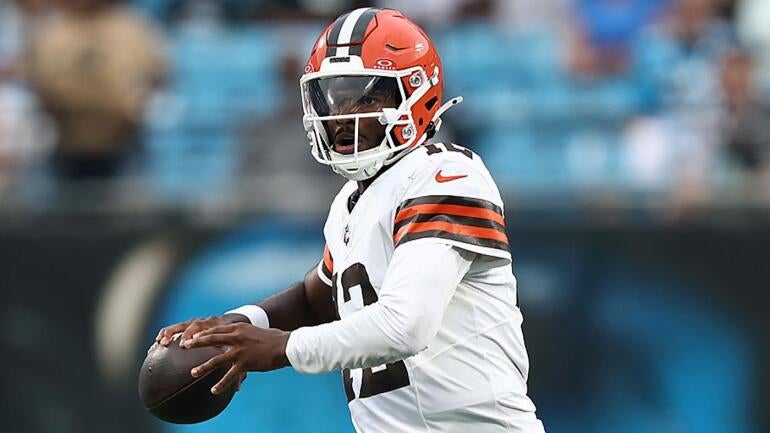
Shedeur Sanders had a forgettable Saturday afternoon against the Rams, a Week 3 preseason game that not only slammed shut the idea that Sanders should have always been in the mix for the starting job in Cleveland, but solidified the notion that he'll begin the regular season right where he began OTAs: as QB4 behind Joe Flacco, Kenny Pickett, and fellow rookie Dillon Gabriel.
And that's OK.
Because you don't need a phone full of league sources to tell you that the Browns preferred Gabriel to Sanders -- we all knew this because they drafted the Oregon QB in the third round, 50 picks before they selected Sanders two rounds later.
This situation isn't exactly the same as the 49ers taking Trey Lance third overall before drafting Mr. Irrelevant Brock Purdy in 2021; or Washington selecting Robert Griffin III No. 2 and then doubling down with Kirk Cousins 100 picks later in 2012, but the underlying point remains: the QB you draft first is the one you're more invested in, at least as you begin the process of evaluating these guys now that they're in your building and in your system.
So while it's easy to get caught up in the social-media firestorm of whether Sanders has been given a fair shake, going back to the draft, when most folks (me included) figured he'd be a late-first-rounder at worst, the reality is that he was QB6, a fifth-rounder who was the second quarterback drafted by the team that eventually selected him.
(Not that it matters, but there was no conspiracy to teach Sanders a lesson; most NFL teams I've spoken with thought he would be a top-50 selection, and every source I talked to was shocked that he went 144th overall.)

Two weeks ago, I wrote about rookie quarterbacks balling out in Week 1 of the preseason and what, if anything, it meant for their long-term NFL prospects (short answer: not much). Sanders was stellar in his debut against the Panthers but that feels like a decade ago now. Before moving forward, it might be instructive to look at Sanders' performance against the Rams -- all 11 dropbacks, 5 sacks, a fumble and only three completions. In part to get a better sense of what happened -- and why it happened -- in part to provide some context for what this might mean for the rest of his rookie season.
Dropback No. 1 (1st-and-10, CLE 40) : Sanders looks right, has the tight end on the stick route, hesitates and scrambles right leaving a clean pocket. Result: Finds the tight end for a 6-yard gain along the sideline on the scramble drill.
Dropback No. 2 (3rd-and-4, CLE 46): All four Browns eligible downfield receivers are blanketed vs. man coverage, the ball should go to RB in the flat on the checkdown. Result: The ball doesn't come out at the top of the drop, LB closes on the checkdown option in the flat, Sanders leaves the pocket, scrambles left and goes out of bounds for a 1-yard loss, which is considered a sack.
Dropback No. 3 (1st-and-10, CLE 15): Play-action and Sanders might have had the TE on the over route if the protection was better. Result: He comes off the over, steps up in the pocket, makes the right decision to get the ball to the RB on the shallow. Sanders is hit as he's throwing, the ball comes out high, goes off the RB's hands and falls incomplete.
Dropback No. 4 (3rd-and-8, CLE 17): It's a three-man route -- all hitches at the first-down marker -- vs. man coverage and all three receivers are well covered. The TE and RB block before releasing into the flat to the left and right, respectively. Result: When Sanders gets to the top of his drop, it's as clean an NFL pocket as you'll see. All three downfield receivers are covered. The TE is open in the flat, and while he probably won't make the line to gain, that's where the ball should probably go. Instead, Sanders leaves the clean pocket, rolls right and overthrows the RB running down the sideline on the scramble drill.
Dropback No. 5 (2nd-and-9, CLE 36): It's a three-step drop and the ball comes out on time. Result: Sanders plays on time, gets the ball to the RB in the flat for a 1-yard gain.
Dropback No. 6 (3rd-and-8, CLE 37): Without knowing the read, it looks like Sanders wants to throw to his No. 3 receiver running an in-breaking route vs. outside leverage before seeing the TE flash on the shallow route going from left to right and an intermediate in-breaking route from the No. 2 receiver behind that. Result: Sanders feels the pressure from his left, and I'm not going to fault him for moving off his spot to the right but the ball has to come out quicker, either to the TE or the in-breaker from the No. 2 WR who was wide open. He gets strip-sacked and the Rams recover. (Look, I get it, it wouldn't have been an easy throw, but that's the point -- this is the NFL, and making those plays, those decisions, is what separates backups from starters.)
Dropback No. 7 (1st-and-10, CLE 48): Under center, play-action to his right with the routes -- short, intermediate and deep -- going to his left. Result: The defensive end to Sanders' left is unblocked, immediately pressures him, Sanders does a nice job of spinning out of trouble but instead of throwing the ball away, he scrambles to the sidelines, runs out of bounds for a 2-yard loss and another sack.
Dropback No. 8 (2nd-and-12, CLE 46): After playing mostly man, the Rams play zone, Sanders looks left, doesn't like what he sees, comes back to his right and the outside receiver is on an in-breaking route near the sticks. Result: As soon as Sanders' eyes get to the No. 1 WR on his right, he takes a hitch, moves back in the pocket, and then bails to avoid the rush. Things go from bad to worse and he takes sack No. 4, losing 24 yards. With the benefit of a time machine, Sanders could have stepped up in the pocket, and while it would've been tight quarters, he would have had a chance to hit that in-breaking route.
Dropback No. 9 (1st-and-10, CLE 46): It's an empty formation and Sanders immediately looks to his left for his RB (lined up as the No. 1 receiver) who runs a stop route. He comes off that, then appears to see his TE on an option route running across the formation in his line of vision four yards from the line of scrimmage. Result: The pocket gets muddy quickly, Sanders tries to maneuver through the pressure and is sacked for the fifth time. He probably could have thrown the RB stop route and while it wouldn't have been an easy throw, Sanders had the TE on the shallow crosser though it likely would have required him to change his arm angle while also not being able to set his feet (but again, that's a garden-variety situation for an NFL QB).
Dropback No. 10 (2nd-and-17, CLE 39): Three-step drop on 2nd-and-long. Result: Ball comes out on time, finds the TE on a hitch for 7 yards.
Dropback No. 11 (3rd-and-10, CLE 46): It's a mesh concept though Sanders appears to look first to his left at his No. 1 and No. 2 receivers running deeper routes. Result: Sanders gets off that initial read quickly, seems to see the shallow route crossing into his field of vision but again instead of stepping up in the pocket and making the throw, he tries to scramble, does a good job of shedding two would-be tacklers, before missing his RB on a throw that probably could have been caught.
Sanders made 35 college starts between Jackson State and Colorado, but the issues that plagued him in Boulder are the same ones that haunted over those 11 dropbacks against the Rams: drifting in the pocket, leaving clean pockets, holding the ball too long while trying to do too much, taking drive-killing sacks and, of course, the turnovers that sometimes followed.
(So, yeah, four of the five offensive linemen blocking for Sanders on that last series were subsequently released by the team. It's worth noting that in Week 1 of the preseason against the Panthers, when Sanders played well, two of those offensive linemen are no longer with the team. If you're wondering – and I was, so I looked that up too – in Gabriel's debut in Week 2 of the preseason, four of the five offensive linemen that started that game are still on the roster. While in Week 3 vs. the Rams, three of the five o-linemen are still on the roster. I wanted to pass that along for completeness, and without judgement. Make of it what you choose.)
This isn't revisionist history -- this is the same scouting report everyone had on Sanders. And that's not to diminish all the things he did well in college. Good luck finding a tougher player whose tape was littered with enough big-time throws to see that aforementioned top-50 potential. In fact, I had been talking about Sanders as a possible first-round talent going back to 2023, when the Buffs started 3-0.
Even 12 months ago, when the race for QB1 was unofficially between Sanders and Cameron Ward, the qualifier was often, "both QBs need to minimize the hero ball and work to play within the confines of the offense because that's what will translate at the next level."
Ward improved over the course of last fall, has a bigger arm, is a better athlete, and perhaps most important, interviewed much better during the pre-draft process than Sanders. In fact, I said often in the weeks after the draft that if Sanders had approached the pre-draft process like Gabriel, he very well could have gone in the first round.
Gabriel, by the way, won't soon be mistaken as a "Built in the lab" NFL quarterback; he's just a shade over 5-foot-11, has 29 5/8-inch arms and 9 1/4-inch hands (by comparison, Anthony Richardson measured almost 6-foot-4, had 32 3/4-inch arms and 10 1/2-inch hands). But what he lacks in physical tools he makes up for in leadership and playmaking ability.
"Decorated college career, very accurate, very poised, throws with anticipation, good mobility," Browns general manager Andrew Berry said shortly after the team drafted Gabriel. "We just thought he had a really well-rounded game. And the biggest negative that you can say about him is that he doesn't have ideal height. But that's not something that we felt like showed up in his game or his film at UCF, Oklahoma, and certainly not at Oregon this year."
And Berry's words from April bring me to the five words that I should probably have taped above my desk: "The tape is the tape."
Which is to say: when you tune out all the online noise, what do these players look like between the whistle? Because over the course of the preseason, Gabriel outplayed Sanders and you could argue it wasn't particularly close. Put aside the box score. Just watching each rep, seeing how Gabriel navigated the offense, got through his reads and threw on time with accuracy and anticipation -- that looked like a rookie quarterback closer to playing in a regular season game than what we saw from Sanders.
Again, this isn't an indictment of Sanders' preseason, it's the story the tape is telling us. More than that, though, Berry has hinted that both rookie QBs are projects at this stage -- even if Gabriel is ahead of Sanders on the depth chart -- and it's why the team will carry four quarterbacks to start the season.
"We have a room that we like all the guys in there," he told NFL Network during the 3rd quarter. "We don't really see that as a problem. We more see it as an opportunity.
"We've largely looked at the last five spots of a roster as more developmental spots, and that can come from any position," Berry continued. "I also think with the roster flexibility nowadays, especially with the elevations that you're able to have on the practice squad, there's just more flexibility in terms of how to build your 48-man game-day roster where it's maybe not as quite as restrictive in the past. Now, that being said, when roster rules were more, let's say, draconian, there have been teams that have carried four. So, if there are four that are 53-man worthy, we think it makes the most sense for us to keep them."
For now, this is Joe Flacco's team. At some point in the next four-plus months, there's a good chance it becomes Gabriel's team, and perhaps even Sanders' team.
Remember, Trey Lance was the starter in San Francisco until he was injured, Brock Purdy seized his opportunity, and never looked back. In Washington, injuries derailed RG3's career and Kirk Cousins was ready when his chance came.
With the benefit of hindsight, yes, both Purdy and Cousins should have been first-round picks. Purdy fell to the seventh round because he was inconsistent in his final year at Iowa State and lacked size and arm strength. And Cousins lasted until the fourth round because while he was the undeniable leader on that team, he was viewed more as a game manager than a legit QB1.
But Purdy and Cousins taught us all an important lesson: scouting reports are neither definitive nor infallible. And this is great news for Sanders.


